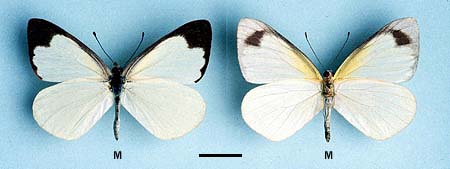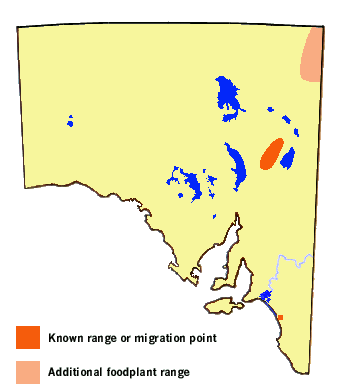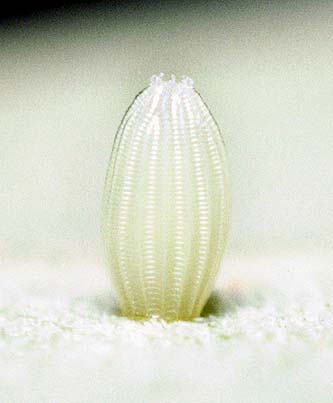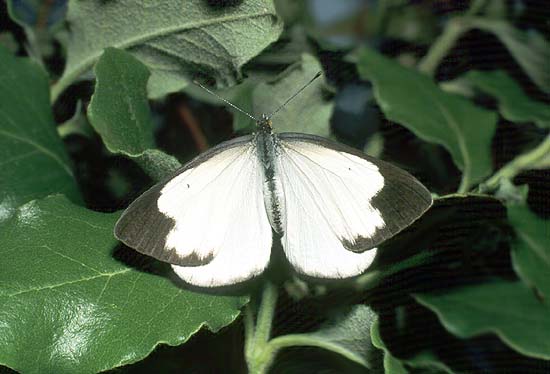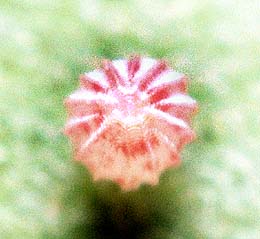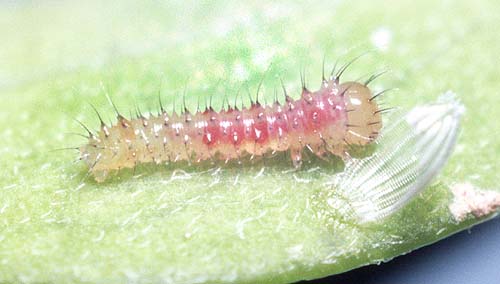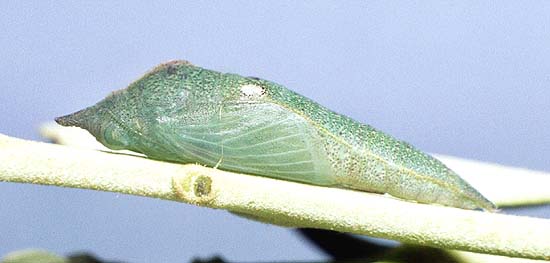Initially pale yellow, gradually becoming brownish or greenish after eating the hostplant,
long cylindrical shaped, the skin is shiny, with dark setae (hairs) arising from small
dark coloured, simple raised bases. The hairs are longest at the anterior and posterior
ends of the larvae, and again dorsally about midway along the larvae. Initially the
anterior dorsal portion of the larva is purplish coloured. This is quickly replaced by
dorsal, purple coloured patches on the second thoracic segment (TS) behind the head, again
mid-dorsally (on abdominal segments AS 2, 3, 4), and again posteriorly on AS 8. The head
is pale yellow, large, rounded, smooth and shining, with a few dark hairs. The larvae eat
their egg shells first, then follow with whatever the eggs were laid on.
Early stages of the larvae have special glandular setae which secrete poison, visible at the
ends of the hairs as clear coloured droplets. The poison tipped setae decrease in number as
the larvae get larger, and by the final instar are absent. The composition of the fluid is
unknown, but is likely to be a deterrent to both invertebrate and small vertebrate predators,
as the hostplants contain irritant glucosinolates, which the larvae are capable of assimilating
and converting into poisons. This affords some protection to the larvae while they feed openly
on the hostplant during the day. Larvae start to produce the poison to the hair tips soon
after they emerge from their egg shells.
The second instar is similar to the first but is noticeably greener and the purple areas become
darker, and the posterior end of the larva has a short fork. All the setae are poison tipped,
including those on the head, and the simple bases of the setae are well developed. There are
some dark purple coloured, larger, specialized scoli-like paired protuberant setae developed
dorsally behind the head on TS 1 and 2, and on AS 2, 4, and 8. There are further large, dark
purple protuberant, subdorsal setae on AS 2, 3, and 4. The third instar is green, with similar
purple markings as before, and only the interspersed longer setae are poison tipped. The forked
tail is better developed, and the body acquires numerous short setae, which impart a scabrous
appearance. The fourth instar is mostly green coloured with a broad pale yellow dorsal line and
the setae have a purplish tinge. The same scoli-like protuberances are present, but are generally
not as well developed except for the dorsal pair on AS 2. The purple dorsal protuberances are
accentuated as they are set in small white coloured patches. The head is very setaceous and
there two pairs of protuberant setae in the front dorsal part. Poison tipped setae are absent.
The first instar larvae eat by initially scouring the green cuticle surface of the hostplant,
be it leaf or stem bark, but quickly move to the leaf edges to devour the entire leaf.
Thereafter, the larvae remain at the leaf edge, and align themselves very closely along the
devoured edge of the leaf, leaving no space between their bodies and the leaf, sometimes
producing intricate contortions to remain in such a position. This posture is a camouflage,
making the larvae appear as a continuous part of the leaf. Later instars have a yellow dorsal
line, which tends to mimic the leaf edge and provide additional camouflage for the feeding
larvae. The larvae will weakly silk the leaves of the hostplant to the stemwhen they are feeding.
The fifth and final instar larvae are similar to the fourth instar, long cylindrical shaped,
about 27 mm long, covered in numerous dark coloured short setae that impart a scabrous
appearance. Poison tipped setae are not present. There are usually paired, small scoli-like
setae developed dorsally on TS 1, 2 and AS 2, 8. There are also protuberant (non-scoli) setae
developed subdorsally on TS 1, 2, AS 2, 3, 4. The posterior end has a divided tail, which is
kept closed so that it looks like a pointed projection. The larvae are green coloured, very
finely dusted purple, with a narrow pale yellow dorsal line, the scoli and protuberant setae
are purple coloured and are sometimes accentuated by a small white area around the base.
When ready to pupate, the larva loses the yellow dorsal line, which it can dispense with in
1/2 hour. The head is green (usually with no pale yellow dorsal line), large, rounded,
covered in short dark setae, with at least two pairs of protuberant setae in the front dorsal
part, the bases of which may be purple or orange coloured.
The larval duration is about 3-4 weeks during spring in Adelaide under captive conditions,
and about 3 weeks in early autumn. It has been reported that larvae during autumn, required
only four instars before pupation.
Angular elongate typical for the subfamily, tapering posteriorly, about 19 mm long.
The head of the pupa has a pointed anterior projection, the thorax has a prominent
dorsal ridge, and there is a lateral flange along the abdomen. The proboscis (on the
ventral side of the pupa) extends beyond the wing areas along the abdomen, and which
seems to be a common attribute of the subfamily, although the trait is particularly
well developed in this butterfly. Mostly coloured in some shade of green, indistinctly
marked with a very fine dusting of purplish markings. The ventral part of the abdomen
is yellowish. There is an indistinct paler dorsal line that is more obvious on the
thoracic ridge, and there is a pale yellow lateral abdominal line. The thoracic ridge
and anterior projection are sometimes purplish coloured. There is sometimes a pair of
either white or purple, widely spaced dorsal spots (of variable clarity) about midway
(AS 2) along the pupa. Attached by a cremaster and central girdle to the outer green
parts of the hostplant, usually a leaf.
The pupation position is random, and pupation may occur with the head pointing either
upwards or downwards, although the former position seems to be preferred. If pupation
occurs on a horizontal leaf then it is usually done on the upperside of the leaf.
The larvae either very weakly secure the leaves to the stem with silk if they pupate
on a leaf, or they do not bother at all. The pupal duration is about 10-11 days during
early summer in Adelaide under captive conditions, while in early autumn it is only 7 days.
